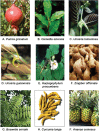Current nutraceuticals in the management of osteoarthritis: a review - PubMed (original) (raw)
Current nutraceuticals in the management of osteoarthritis: a review
Nahid Akhtar et al. Ther Adv Musculoskelet Dis. 2012 Jun.
Abstract
Osteoarthritis (OA) is a progressive degenerative joint disease that has a major impact on joint function and quality of life. Nutraceuticals and dietary supplements derived from herbs have long been used in traditional medicine and there is considerable evidence that nutraceuticals may play an important role in inflammation and joint destruction in OA. We review the biological effects of some medicinal fruits and herbs - pomegranate, green tea, cat's claw, devil's claw, ginger, Indian olibaum, turmeric and ananas - in an attempt to understand the pivotal molecular targets involved in inflammation and the joint destruction process and to summarize their toxicities and efficacy for OA management. So far there is insufficient reliable evidence on the effectiveness of ginger, turmeric and ananas. Pomegranate and green tea only have preclinical evidence of efficacy due to the lack of clinical data. In vivo and clinical studies are required to understand their targets and efficacy in OA. Limited in vitro and in vivo evidence is available for cat's claw and Indian olibaum. More extensive studies are required before long-term controlled trials of whole cat's claw and Indian olibaum extracts, or isolated active compounds, are carried out in patients with OA to determine their long-term efficacy and safety. Devil's claw has not been rigorously tested to determine its antiarthritic potential in in vitro and in vivo models. There is strong clinical evidence of the effectiveness of devil's claw in pain reduction. However, high-quality clinical trials are needed to determine its effectiveness. No serious side effects have been reported for any fruits and herbs. Overall, these studies identify and support the use of nutraceuticals to provide symptomatic relief to patients with OA and to be used as adjunct therapy for OA management. More high-quality trials are needed to provide definitive answers to questions related to their efficacy and safety for OA prevention and/or treatment.
Keywords: cat’s claw; green tea; inflammation; osteoarthritis; pomegranate.
Conflict of interest statement
The authors declare that there is no conflict of interest.
Figures
Figure 1.
Medicinal fruits and herbs commonly used as dietary supplements for the treatment of osteoarthritis. Sources: Punica granatum:
http://web.gccaz.edu/glendalelibrary/GLIS%20Punica%20granatum.htm
; Camellia sinensis:
http://www.evitamins.com/encyclopedia/assets/nutritional-supplement/green-tea/how-it-works
; Uncaria tomentosa:
http://www.europhyto.com/phyto-immune-defence/uncaria-tomentosa.asp
; Uncaria guianensis:
http://www.tradenote.net/claw\_3/
; Harpagophytum procumbens:
http://www.agric.wa.gov.au/objtwr/imported\_images/decplants/devilsclaw.gif
; Zingiber officinale:
http://medicinegardenwellness.com/shoppe/index.php?main\_page=product\_info&products\_id=136
; Boswellia serrata:
http://www.sssbiotic.com/product/Boswellia.asp
; Curcuma longa:
; Ananas comosus:
http://www.virboga.de/video/pics/Ananas\_comosus\_001802.jpg
Similar articles
- Current status of top 10 nutraceuticals used for Knee Osteoarthritis in India.
Vaishya R, Agarwal AK, Shah A, Vijay V, Vaish A. Vaishya R, et al. J Clin Orthop Trauma. 2018 Oct-Dec;9(4):338-348. doi: 10.1016/j.jcot.2018.07.015. Epub 2018 Jul 20. J Clin Orthop Trauma. 2018. PMID: 30449982 Free PMC article. Review. - Devil's Claw (Harpagophytum procumbens) as a treatment for osteoarthritis: a review of efficacy and safety.
Brien S, Lewith GT, McGregor G. Brien S, et al. J Altern Complement Med. 2006 Dec;12(10):981-93. doi: 10.1089/acm.2006.12.981. J Altern Complement Med. 2006. PMID: 17212570 Review. - Toxicological aspects of the South American herbs cat's claw (Uncaria tomentosa) and Maca (Lepidium meyenii) : a critical synopsis.
Valerio LG Jr, Gonzales GF. Valerio LG Jr, et al. Toxicol Rev. 2005;24(1):11-35. doi: 10.2165/00139709-200524010-00002. Toxicol Rev. 2005. PMID: 16042502 Review. - Efficacy and safety of freeze-dried cat's claw in osteoarthritis of the knee: mechanisms of action of the species Uncaria guianensis.
Piscoya J, Rodriguez Z, Bustamante SA, Okuhama NN, Miller MJ, Sandoval M. Piscoya J, et al. Inflamm Res. 2001 Sep;50(9):442-8. doi: 10.1007/PL00000268. Inflamm Res. 2001. PMID: 11603848 Clinical Trial. - Antioxidants and antiinflammatory dietary supplements for osteoarthritis and rheumatoid arthritis.
Rosenbaum CC, O'Mathúna DP, Chavez M, Shields K. Rosenbaum CC, et al. Altern Ther Health Med. 2010 Mar-Apr;16(2):32-40. Altern Ther Health Med. 2010. PMID: 20232616 Review.
Cited by
- Osteoarthritis: Insights into Diagnosis, Pathophysiology, Therapeutic Avenues, and the Potential of Natural Extracts.
Coppola C, Greco M, Munir A, Musarò D, Quarta S, Massaro M, Lionetto MG, Maffia M. Coppola C, et al. Curr Issues Mol Biol. 2024 Apr 29;46(5):4063-4105. doi: 10.3390/cimb46050251. Curr Issues Mol Biol. 2024. PMID: 38785519 Free PMC article. Review. - A Systemic Review on Nutraceutical Supplements used in the Management of Osteoarthritis.
Nooreen Z, Wal P, Summaiyya F. Nooreen Z, et al. Recent Adv Food Nutr Agric. 2024;15(1):33-45. doi: 10.2174/012772574X270405231102054920. Recent Adv Food Nutr Agric. 2024. PMID: 38258782 Review. - The role of ageing and oxidative stress in intervertebral disc degeneration.
Wen P, Zheng B, Zhang B, Ma T, Hao L, Zhang Y. Wen P, et al. Front Mol Biosci. 2022 Nov 7;9:1052878. doi: 10.3389/fmolb.2022.1052878. eCollection 2022. Front Mol Biosci. 2022. PMID: 36419928 Free PMC article. Review. - The Nutraceuticals as Modern Key to Achieve Erythrocyte Oxidative Stress Fighting in Osteoarthritis.
Mariano A, Bigioni I, Misiti F, Fattorini L, Scotto D'Abusco A, Rodio A. Mariano A, et al. Curr Issues Mol Biol. 2022 Aug 5;44(8):3481-3495. doi: 10.3390/cimb44080240. Curr Issues Mol Biol. 2022. PMID: 36005136 Free PMC article. Review.
References
- Abramson S.B. (2003) The role of NSAIDs in the treatment of osteoarthritis. In Brandt K.D., Doherty M., Lohmander L.S. (eds), Osteoarthritis. Oxford: Oxford University Press, pp. 251–258
- Afzal M., Al-Hadidi D., Menon M., Pesek J., Dhami M.S. (2001) Ginger: an ethnomedical, chemical and pharmacological review. Drug Metabol Drug Interact 18: 159–190 - PubMed
- Aggarwal B.B., Shishodia S. (2004) Suppression of the nuclear factor-κB activation pathway by spice-derived phytochemicals: reasoning for seasoning. Ann N Y Acad Sci 1030: 434–441 - PubMed
- Aguilar J.L., Rojas P., Marcelo A., Plaza A., Bauer R., Reininger E., et al. (2002) Anti-inflammatory activity of two different extracts of Uncaria tomentosa (Rubiaceae). J Ethnopharmacol 81: 271–276 - PubMed
LinkOut - more resources
Full Text Sources
Miscellaneous
